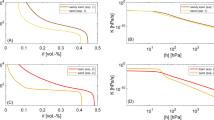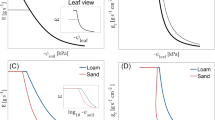Summary
Well watered plants of Vigna unguiculata (L.) Walp cv. California Blackeye No. 5 had maximum photosynthetic rates of 16 μmol m-2 s-1 (at ambient CO2 concentration and environmental parameters optimal for high CO2 uptake). Leaf conductance declined with increasing water vapour concentration difference between leaf and air (Δw), but it increased with increasing leaf temperature at a constant small Δw. When light was varied, CO2 assimilation and leaf conductance were correlated linearly. We tested the hypothesis that g was controlled by photosynthesis via intercellular CO2 concentration (c i). No unique relationship between (1) c i, (2) the difference between ambient CO2 concentration (c a) and c i, namely c a-c i, or (3) the c i/c a ratio and g was found. g and A appeared to respond to environmental factors fairly independently of each other. The effects of different rates of soil drying on leaf gas exchange were studied. At unchanged air humidity, different rates of soil drying were produced by using (a) different soils, (b) different irrigation schemes and (c) different soil volumes per plant. Although the soil dried to wilting point the relative leaf water content was little affected. Different soil drying rates always resulted in the same response of photosynthetic capacity (A max) and corresponding leaf conductance (g(Amax)) when plotted against percent relative plant-extractable soil water content (W e %) but the relationship with relative soil water content (W e ) was less clear. Above a range of W e of 15%–25%, A max and g(Amax) were both high and responded little to decreasing W e . As soon as W e fell below this range, A max and g(Amax) declined. The data suggest root-to-leaf communication not mediated via relative leaf water content. However, g(Amax) was initially more affected than A max.
Similar content being viewed by others
Abbreviations
- A CO2 :
-
assimilation
- A max :
-
photosynthetic capacity at favourable ambient conditions
- c a CO2 :
-
concentration of the air in the leaf chamber
- c i :
-
intercellular
- CO2 :
-
concentration
- E :
-
transpiration
- g :
-
leaf conductance
- g(Amax):
-
leaf conductance corresponding to photosynthetic capacity
- I :
-
photon flux rate
- T l :
-
leaf temperature
- W e :
-
relative plant-extractable soil water content
- W e :
-
absolute plant-extractable soil water content
- W l :
-
relative leaf water content
- W s :
-
relative soil water content
- Δw :
-
difference in water vapour mole fraction between leaf and air
- Ψ:
-
leaf water potential
References
Ball MC (1981) Physiology of photosynthesis in two mangrove species: responses to salinity and other environmental factors. PhD thesis, Australian National University, Canberra
Bates LM, Hall AE (1981) Stomatal closure with soil water depletion not associated with changes in bulk leaf water status. Ecologia (Berlin) 50:62–65
Bates LM, Hall AE (1982) Relationship between leaf water status and transpiration of cowpea with progressive soil drying. Oecologia (Berlin) 53:285–289
Blackman PG, Davies WJ (1985) Root to shoot communication in maize plants of the effects of soil drying. J Exp Bot 36(162):39–48
Bunce JA (1984) Effects of humidity on photosynthesis. J Exp Bot 35:1245–1251
Catsky J (1960) Determination of water deficit in discs cut out from leaf blades. Biol Plant 2:76–78
Comstock J, Ehleringer JR (1984) Photosynthetic responses to slowly decreasing leaf water potentials in Encelia frustescens. Oecologia (Berlin) 61:241–248
Dubbe DR, Farquhar GD, Raschke K (1978) Effect of abscisic acid on the gain of the feedback loop involving carbon dioxide and stomata. Plant Physiol 62:413–417
Gollan T, Turner NC, Schulze E-D (1985) The responses of stomata and leaf gas exchange to vapour pressure deficits and soil water content. III. In the sclerophyllous woody species Nerium oleander. Oecologia (Berlin) 65:356–362
Gollan T, Passioura JB, Munns RE (1986) Soil water status affects the stomatal conductance of fully turgid wheat and sunflower leaves. Aust J Plant Physiol 13:459–464
Hall AE, Schulze E-D, Lange OL (1976) Current perspectives of steady-state stomatal responses to environment. In: Lange OL, Kappen L, Schulze E-D (eds) Water and Plant Life. Ecological Studies 19, pp 169–188
Körner C, Scheel J, Bauer H (1979) Maximum leaf diffusive conductance in vascular plants. Photosynthetica 13:45–82
Küppers BIL (1983) Die Beziehung zwischen CO2-Assimilation und Blattleitfähigkeit bei Düngung und Wasserstreß. Untersuchungen an Vigna unguiculata (L.) Walp und Urtica dioica L.. Diplomarbeit, Bayreuth
Küppers M (1984) Carbon relations and competition between woody species in a Central European hedgerow. II. Stomatal responses, water use, and conductivity to liquid water in the root/leaf pathway. Oecologia (Berlin) 64:344–354
Küppers M, Schulze E-D (1985) An empirical model of net photosynthesis and leaf conductance for the simulation of diurnal courses of CO2 and H2O exchange. Aust J Plant Physiol 12:513–526
Küppers M, Hall AE, Schulze E-D (1982) Effects of day-to-day changes in root temperature on leaf conductance to water vapour and CO2 assimilation rates of Vigna unguiculata L. Walp. Oecologia (Berlin) 52:116–120
Küppers M, Matyssek R, Schulze E-D (1986) Diurnal variation of light-saturated CO2 assimilation and the response of intercellular CO2 concentration. Oecologia (Berlin) 69:477–480
Lange OL, Tenhunen JD, Beyschlag W (1985) Effects of humidity during diurnal courses on the CO2-and light-saturated rate of net CO2 uptake in the sclerophyllous leaves of Arbutus unedo. Oecologia (Berlin) 67:301–304
Nagarajah S, Schulze E-D (1983) Responses of Vigna unguiculata (L.) Walp. to atmospheric and soil drought. Aust J Plant Physiol 10:385–394
Raschke K, Hedrich R (1985) Simultaneous and independent effects of abscisic acid on stomata and the photosynthetic apparatus in whole leaves. Planta 163:105–118
Ritchie JT (1974) Atmospheric and soil water influences on the plant water balance. Agric Meteorol 14:183–198
Schulze E-D (1986) Carbon dioxide and water vapour exchange in response to drought in the atmosphere and in the soil. Ann Rev Plant Physiol 37
Schulze E-D, Hall AE (1982) Stomatal responses, water loss and CO2 assimilation rates of plants in contrasting environments. In: Lange OL, Nobel PS, Osmond CB, Ziegler H (eds) Physiological plant ecology II. Springer, Berlin Heidelberg New York, pp 181–230
Schulze E-D, Küppers M (1979) Short-term and long-term effects of plant water deficits on stomatal response to humidity in Corylus avellana L. Planta 146:319–326
Schulze E-D, Lange OL, Buschbom U, Kappen L, Evenari M (1972) Stomatal response to changes in humidity in plants growing in the desert. Planta 108:259–270
Schulze E-D, Schilling K, Nagarajah S (1983) Carbohydrate partitioning in relation to whole plant production and water use of Vigna unguiculata (L.) Walp. Oecologia (Berlin) 58:169–177
Sharkey TD (1984) Transpiration-induced changes in the photosynthetic capacity of leaves. Planta 160:143–150
Sinclair TR, Ludlow MM (1986) Influence of soil water supply on the plant water balance of four tropical grain legumes. Aust J Plant Physiol 13:329–341
Terashima I, Wong SC, Osmond CB, Farquhar GD (1988) Characterization of non-uniform photosynthesis induced by abscisic acid in the leaves having different mesophyll anatomies. Plant Cell Physiol (in press)
Turk KJ, Hall AE (1980) Drought adaptation of cowpea. II. Influence of drought on plant water status and relations with seed yield. Agron J 72:421–427
Turner NC (1974) Stomatal response to light and water under field conditions. R Soc NZ Bull 12:423–432
Turner NC, Schulze E-D, Gollan T (1985) The responses of stomata and leaf gas exchange to vapour pressure deficits and soil water content. II. In the mesophytic herbaceous species Helianthus annuus. Oecologia (Berlin) 65:348–355
Wong SC, Cowan IR, Farquhar GD (1979) Stomatal control correlates with photosynthetic capacity. Nature (London) 282:424–426
Author information
Authors and Affiliations
Rights and permissions
About this article
Cite this article
Küppers, B.I.L., Küppers, M. & Schulze, E.D. Soil drying and its effect on leaf conductance and CO2 assimilation of Vigna unguiculata (L.) Walp. Oecologia 75, 99–104 (1988). https://doi.org/10.1007/BF00378820
Received:
Issue Date:
DOI: https://doi.org/10.1007/BF00378820




